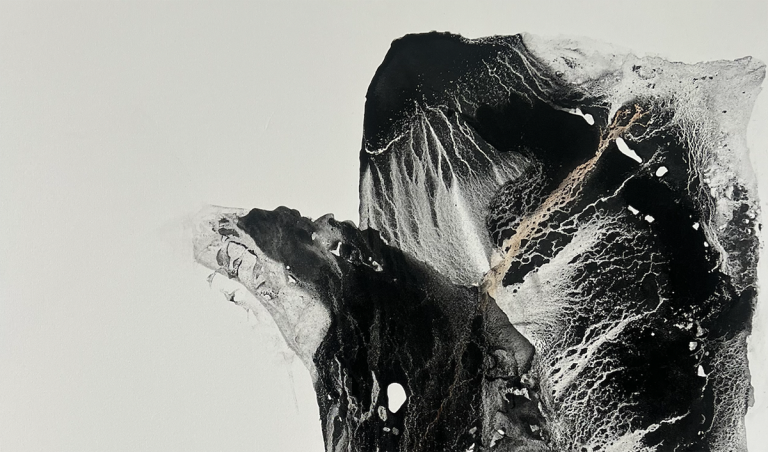Marina Chisty is a Russian-born artist whose work feels both personal and universal. After moving from Russia to the United States, she carried with her not just memories of home but also an instinctive understanding that art can speak across borders, across languages. Her paintings don’t shout—they linger. They work like quiet meditations, full of tension and gentleness, made of shape and mood rather than fixed narratives. She isn’t trying to explain the world. She’s letting you feel it.
Chisty’s process blends discipline with intuition. She works with a mix of materials—powdered pigments, charcoal, acrylics—but there’s nothing showy about it. What she builds is atmosphere. You don’t look at her work for information. You stand in front of it because something about it holds you in place.
One painting in particular captures this best. It’s called Balance.

Balance is 48 by 60 inches—large enough to take up space, but soft in presence. There’s no crowd of detail here. No narrative to unpack. Instead, it asks you to slow down. The surface carries a kind of rhythm. Pigment powder blurs into charcoal, charcoal breaks into acrylic. There are ink-like shapes, drifting in and out of each other, like breath in slow motion.
You can’t really tell where one form ends and the next begins. And maybe that’s the point. Chisty isn’t interested in edges. She’s interested in what happens in between. There’s movement, but it’s quiet—like watching clouds or still water that’s just barely disturbed.
It’s called Balance, but nothing about it feels symmetrical. There’s no perfect split of dark and light. Instead, the painting feels like a conversation. One side waits while the other speaks. The dark doesn’t overpower the light. The light doesn’t erase the dark. They coexist, with a kind of respect.
Some marks feel free, like gestures caught in a moment of impulse. Others feel placed with care, maybe reconsidered, maybe layered over and over until they stopped asking questions. That tension—the space between freedom and control—is where the painting lives.
What makes Balance interesting is that it doesn’t resolve itself. You never get the satisfaction of a tidy ending. You just get held in place, in that space between inhale and exhale. It’s a painting about stillness, but also about how hard stillness can be.
Look closer, and the materials begin to tell their own story. Pigment powder settles into the weave of the canvas. It doesn’t sit on top—it sinks in. Charcoal leaves behind that raw, dry texture you can almost feel just by looking. Acrylic drifts across it all like water or smoke.
There’s a humility to the materials. No gloss, no tricks. Chisty isn’t trying to impress. She’s inviting. That matters. Especially now, when so much art feels loud, full of statement and spectacle. Balance is the opposite. It doesn’t perform. It listens.
That sense of listening—of letting the work reveal itself slowly—is something Chisty seems to value. It’s part of what makes her work feel honest. Not in the sense of autobiography, but in how it honors process, ambiguity, restraint.
And that’s what Balance offers: not answers, not bold declarations, but a quiet place to stand. A reminder that not everything needs to be solved or even fully understood. That sometimes, the unresolved is enough.
In Chisty’s hands, balance isn’t a fixed point. It’s a practice. A movement between forces. A kind of trust in tension. The painting holds that tension like a breath it’s not ready to let go.
And maybe that’s what draws people in. Not because it tells them what to feel—but because it gives them space to feel it.


